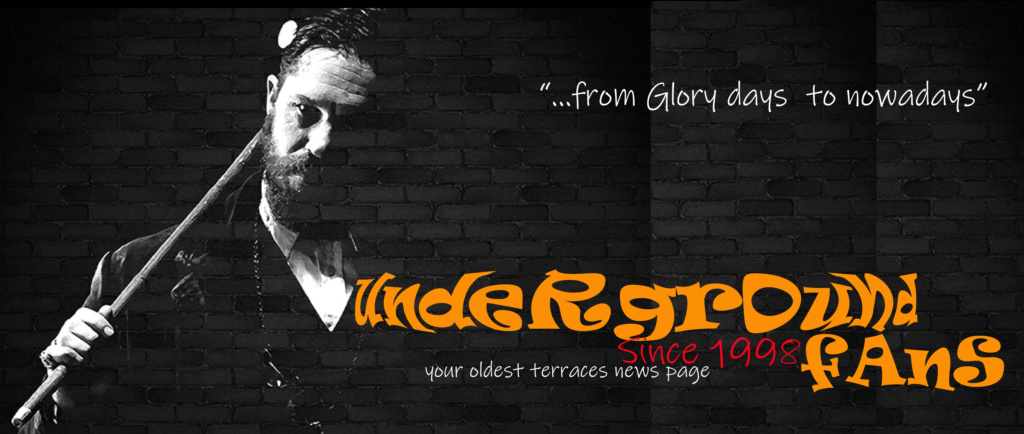Hooliganism still a dirty stain in football - 02/04/2014Source : http://www.stuff.co.nz

The violent death of a fan on the opening weekend of the Swedish season at the weekend was a sharp reminder that while riots in Europe's stadiums are largely a thing of the past, hooliganism has not been eradicated.
Modern policing and stewarding, and widespread use of CCTV, has meant that most stadiums are largely trouble-free environments on the inside and few now have the need for fenced segregation.
However, as the appalling events in Sweden showed, when a Djurgarden fan in his 40s died after being assaulted on his way to a game in Helsingborg, associated violence is still rife in many places.
Below we examine the current hooligan situation around Europe:
SCANDINAVIA
The death of father of four Stefan Isaksson has thrust the hooligan problem back into the spotlight in Sweden.
According to police reports he was struck on the head with a blunt instrument before being kicked and beaten as he made his way to see his side take on Helsingborg.
The game went ahead as planned, but was abandoned when his fellow fans invaded the pitch having received reports that he had died in hospital from his injuries.
Ministers from a government led by Djurgarden fan Fredrik Reinfeldt were quick to respond. Justice minister Beatrice Ask suggested supporter culture was to blame for the violence.
Sweden has long struggled to come to terms with such violence, as "firms" attached to big-city clubs arrange fights often far away from arenas. But in some cases trouble still takes place at football grounds in the region.
AIK were fined 60,000 euros by UEFA when Levski Sofia's bus was attacked by stone-throwing hooligans after a Europa League qualifier in 2010. The Bulgarian club's chairman, masseuse, press officer and two players were also struck by missiles.
A recent Swedish second-tier game between Hammarby and GAIS was interrupted when Hammarby fans invaded a closed section over the away support and began raining missiles onto them.
For their part, Swedish fans have accused Swedish police of being heavy-handed and claimed that they only fight only against fellow hooligans. Regular scarf-wearing fans - called "Christmas trees" by the hooligan "casuals" as they wear bright club colours - are usually left alone and not involved in the violence.
Across the Oresund in Denmark the problem also exists, and though it has receded somewhat in recent years it is not unusual for groups from southern Sweden and Denmark to join forces for fights against other firms.
A video clip of a pre-arranged fight between supporters of Gothenburg club GAIS and groups of fans of Helsingborg and FC Copenhagen spread quickly across the internet in July
Norway - home of the Nobel peace prize - is much calmer than its Nordic neighbours, with few violent incidents or organised battles taking place.
RUSSIA
Football hooliganism has been on the rise in Russia since the fall of the Soviet Union in 1991.
"Firms", are now attached to all of the country's major clubs and fights between hooligans and scuffles with police are a regular phenomenon in the Russian leagues, either starting spontaneously at stadiums or as pre-agreed battles in remote sites. Violence is often accompanied by nationalist or racist slogans and symbols.
Ad Feedback
In one recent case Spartak Moscow and Shinnik Yaroslavl were fined and ordered to play matches behind closed doors following violence at a cup match where Nazi banners were unfurled.
In 2010, several thousand youths rioted outside the Kremlin, clashing with police and attacking passers-by who they took for non-Russians, after the death of an ethnic Russian soccer fan was blamed on a man from the North Caucasus.
President Vladimir Putin, seeking to appease soccer fans and soothe the worst outbreak of ethnic violence in Moscow in post-Soviet history, met with football enthusiasts and laid flowers at the grave of the dead supporter, Yegor Sviridov. Many observers, however, say that his death and much of the violence is related to ethnic tensions rather than football.
Russia introduced a "supporters law" this year, which enables courts to ban fans from grounds for up to seven years but the Government, Russian Football Union, the clubs and police routinely pass the buck when it comes to responsibility for the problems.
A fictional film titled "Around football", which tells the story of Spartak "firm" members who ignore potentially tragic consequences to make fighting for their club the essence of their lives was also recently released.
ITALY
Italy is famous for its "ultras", groups of hardcore fans who are frequently behind the stadium violence which has dogged all levels of the country's football since the 1970s.
The death of policeman Filippo Raciti during the fighting that followed the Catania-Palermo derby of February 2007 led authorities to introduce a number of hardline measures.
These included blanket bans on away fan travel, banning orders handed out by the police rather than the courts and an ID card scheme which has targeted normal fans and hooligans alike.
Some major flare-ups still occur, however, with Rome derbies blighted by stabbings and clashes with police, while this season's match between Bologna and Hellas Verona was the scene of fighting between rival fans.
Violence is not limited solely to stadiums, but also the surrounding areas and motorway service stations as fans criss-cross the country in large organised groups.
Ultras use knives, but rarely to inflict serious harm, and talk about "light stabbing" to mean knife attacks on an opposing fans' buttocks.
GREECE
Greece is undoubtedly one of European football's violence blackspots and has a chequered track record of incidents including pitch invasions, stabbings and attacks on police.
Fighting involving organised fan clubs is commonplace.
The main culprits are the traditional big clubs, Olympiakos Piraeus, Panathinaikos, AEK Athens and PAOK Salonika, and, like in Italy, it is common for the 'ultras' factions around those teams to clash both inside and outside of stadiums before and after matches.
There is an emerging trend for hooligans to target sports other than soccer, such as handball, volleyball and water polo where there is usually a limited police presence.
All of those clubs listed have been punished with heavy fines and have been forced to play matches behind closed doors in recent seasons as part of an attempted crackdown from the government, the Greek FA and the Super League.
A hardline sports law was introduced by the government in 2012 and was the culmination of several years' work after the fatal stabbing of an Olympiakos fan four years earlier had prompted the authorities to get tough on violence.
The stiffest penalty imposed by the Greek league was for Panathinaikos, who were docked five points and forced to play four games behind closed doors in March 2012 as punishment for crowd violence following a derby against Olympiakos.
The match was abandoned after being interrupted twice by crowd trouble when sections of the stadium were set on fire and police were also attacked.
Players union Fifpro set up a special European task force in 2011 to look into attacks by fans on players and cited Greece as one of the focus countries.
BALKANS
Football hooliganism was non-existent under communist rule in the former Yugoslavia but the country's bloody break-up in the 1990s let the genie out of the bottle, as it went hand in hand with political strife, ethnic tensions and economic depression.
Serbia and Croatia came to the fore, especially the former as the Belgrade derby between bitter city foes Red Star and Partizan became a fixture with a history of regular crowd trouble, producing several fatalities down the years.
Violence rarely occurs near the heavily-policed stadiums, but brawls, in which fans fight each other with iron bars, baseball bats and whatever else they can find, are regularly sighted in Belgrade's outskirts and even in the city's central residential areas on match days.
An horrific incident occurred in 1999, when a Red Star fan was killed by a propelled flare launched from the Partizan end that flew across the pitch above the players' heads and into the visiting supporters' section.
A French fan was also killed in Belgrade city centre hours before Partizan played Toulouse in the Europa League in 2009.
The offenders were handed long prison terms after a public outcry in Serbia demanding the government take a tougher stance.
More recently, Red Star fans burned several hundred seats in Partizan's stadium in May while their rivals hit back in November by lighting a terrace bonfire that held up play for 10 minutes as officials waited for the billowing smoke to clear.
Fan violence is also common in Bosnia, where several matches were abandoned in the past few years because of crowd trouble. Last week 13 fans and three policemen were injured in fierce clashes between supporters of city rivals Sarajevo and Zeljeznicar during their cup tie.
TURKEY
Turkey is no stranger to soccer violence with numerous incidents occurring this season.
A major Istanbul derby between Besiktas and Galatasaray was halted and later cancelled in September when fans invaded the pitch, with police using teargas to disperse the crowd.
Galatasaray were awarded the match and Besiktas were ordered to play four home games with only women and children in the stands.
One fan died and another was critically injured when they were stabbed at a protest staged by Fenerbahce fans in July against UEFA's decision to ban the club from European competition.
A similar incident occurred last May when Galatasaray fans stabbed to death a teenager wearing a Fenerbahce shirt at a bus stop after an end-of-season derby in Istanbul.
The Turkish football federation replaced their policy of punishing teams with stadium supporter bans in 2011, choosing instead to allow women and children to attend.
In March Trabzonspor's match against Fenerbahce was abandoned in the first half after Fenerbahce players were pelted with objects thrown onto the pitch by home fans.
Supporters also clashed with police in the streets of Trabzon following the match and Trabzonspor were later punished with a six-game "no fans" ban.
SWITZERLAND
Switzerland's reputation for peace, quiet and orderliness does not extend to its football fans.
The country has been plagued by soccer violence and FIFA president Sepp Blatter once said that the country which hosts soccer's governing body was years behind its neighbours in fighting the problem.
Last season's Swiss Cup final in the capital of Berne was marred by a fighting between fans of Basel and Grasshoppers, who threw firecrackers and stones at each other in the historic centre of the city before the game.
Also at the end of last season, Aarau's promotion celebrations turned sour when a fan set off a pyrotechnic inside a nightclub, sparking a brawl which involved pepper spray and an eventual evacuation of the venue.
Blick newspaper reported that several Aarau players were present at the time.
The most serious incident happened in 2011 when a Grasshoppers and FC Zurich derby was interrupted as rival fans threw fireworks at each other.
FIFA withdrew funding for a new municipal stadium in Zurich - where all matches are currently played at the Letzigrund athletics stadium - because of plans to include standing areas.
NETHERLANDS
Football violence in the Netherlands remains a major problem with top matches regularly scheduled with early kickoffs and some cities banning away fans.
Supporters organising fights on the fringes of games has been a problem dating back decades, while there have also been attacks on police and visiting foreign fans for European games.
Last November there were serious clashes between Ajax and Celtic fans ahead of a Champions League match that resulted in almost 50 arrests of fans from both teams.
Legislation against hooliganism is quite broad - including forcing known trouble makers to report to police stations while games are going on.
In September Eindhoven's mayor refused to allow Ajax fans to be bussed into the city for what is regarded as one of the key games of the season and other cities and towns have also banned away fans.
There have been violent incidents outside of the professional game and a volunteer linesman, Richard Nieuwenhuizen, died last December after he was set upon by a group of teenage players at an amateur match.
PORTUGAL
Hooliganism in Portugal is infrequent and almost always involves the big three clubs, Porto, Benfica and Sporting.
A recent flashpoint occurred in October when 48 people were injured as fans clashed outside the Dragao stadium ahead of a league game between Porto and Sporting.
A group, mostly dressed in black and not wearing any club colours, arrived in formation outside the stadium, chanting and provoking nearby Porto fans, with skirmishes erupting soon after.
ENGLAND
England, which suffered so badly with hooliganism in the 1970s and 80s that the problem was sometimes described as "the English disease", has largely put its house in order.
A concentrated clamp-down by police, involving detailed intelligence operations, helped identify many of the regular trouble-makers and banning orders kept them away from grounds.
As with many other countries, trouble still occurs further away from grounds while there are still regular problems in many lower league games, often unreported as they take place away from the media spotlight.
Generally, however, most grounds are now considered safe destinations and colour-draped fans of opposing teams can usually be seen travelling alongside each other to the game - unthinkable 20 years ago.
FRANCE
There is a difference between 'ultras' and hooligans in France. Ultras are known for their fanatical support and use of flares, but they are usually not out for violence.
While hooliganism is on the decline in France, the problem has not been fully crushed, with Paris St Germain and Olympique Lyon two of the clubs where trouble has been known to flare up, especially around European games.
PSG implemented the 'Plan Leproux' (Robin Leproux, former PSG president) in 2010 to eradicate all fans groups at the club, which had a big impact on disrupting hooliganism.
Nationwide, preventative measures include stadium banning orders, with flexibility to increase the length of the ban.
There is also better coordination between police and public authorities to quash trouble in advance, rather than reacting to incidents.
There is sometimes trouble at smaller matches, such as the eastern derby between Nancy and Metz, with hooligans meeting for pre-arranged fights, while PSG fans battled rivals from Bayer Leverkusen in a pre-planned fight before a Champions League clash last month.
GERMANY
Germany has seen cases of hooliganism drop from their height in the 1980s but matches are still marred by clashes, usually outside the stadium or in the city.
Borussia Dortmund and Schalke 04 fans keep police busy whenever the two Ruhr valley sides meet and extensive clashes between the two sides occurred as recently as October 2012, when some 200 fans in total were detained.
The league's (DFL) biggest day-to-day problem however is the use of flares inside stadiums, including in that derby where Dortmund fans lit dozens and threw them into the Schalke tribunes, delaying the start of the game.
Dortmund boss Hans-Joachim Watzke has pledged to crack down on his own ultras and Dortmund were sanctioned for their fans' behaviour.
There are also regular incidents in the second Bundesliga with police under attack from some 200 Cologne fans in March after they had tried first to attack Karlsruhe supporters.
In the most spectacular sanction Dynamo Dresden were banned from competing in the German Cup this season after repeated offence by their fans.
